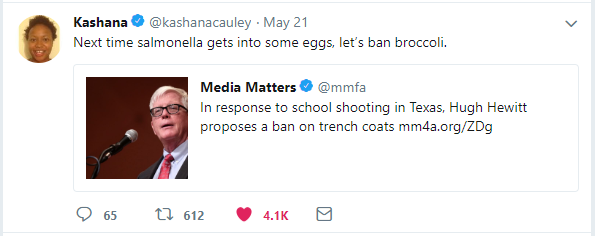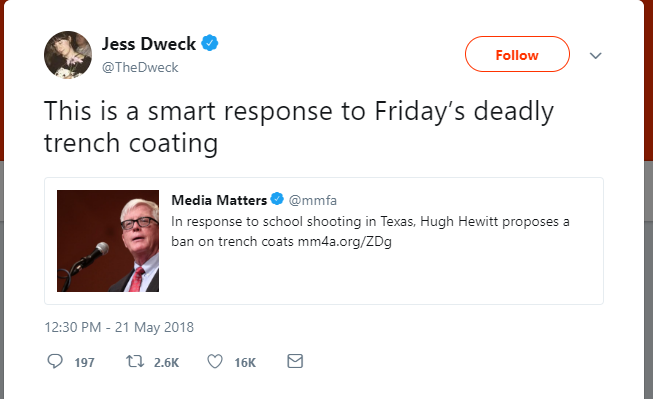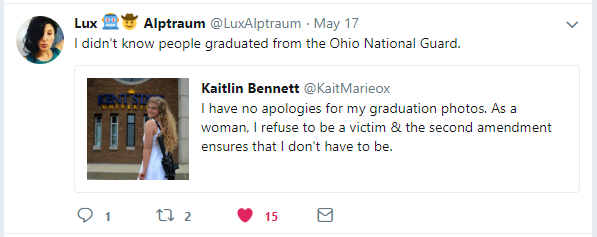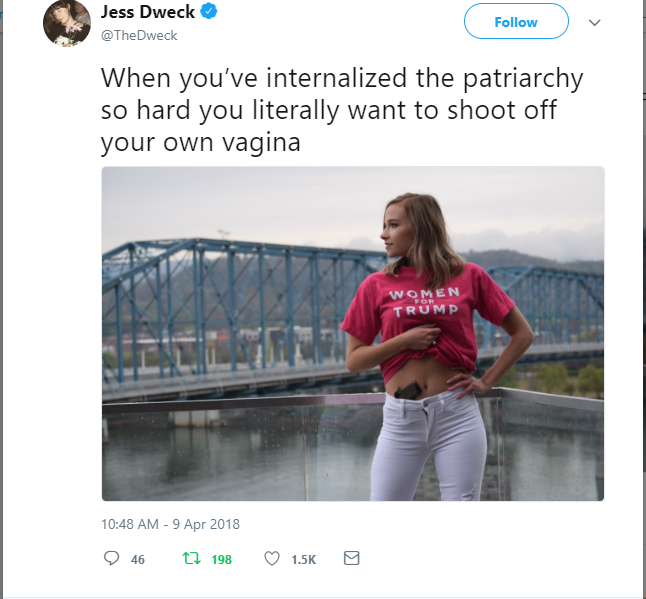
What We Talk About When We Talk About Guns
As an American, gun violence and mass shootings are a constant point of discussion in my online and offline life. In a world where most young people get most of their news through social media, this article examines how social media serves to entrench narratives and create ludic discourse communities.
Where and How We Talk About Gun Violence
Over the course of keeping a social media diary for the course Discourse and Media Theory, it became apparent that I had become one of those petulant millennials who relies exclusively on social media for her news. Though I do follow a variety of reputable news organizations (namely the BBC, New York Times, Huffington Post, NPR, and The Associated Press) their tweets are often dwarfed by those of writers, journalists, comedians and podcasters I follow. Often long before I ever read the actual details of a news story, I’ve waded through 50 tweets of commentary about it. Being an international student, I use Twitter to aggregate news from home in a central location, then filter its importance by the extent to which a given event is being discussed. It’s hardly a perfect system, but in a society that has a 24-hour news cycle it’s easy to become overwhelmed.
How are Americans, who according to my Dutch friends are notoriously sensitive, able to make jokes about mass shootings?
Being American, a disturbing amount of news events that get filtered through my twitter feed are mass shootings. At the outset of developing this article, I was interested in the discourse on twitter surrounding gun violence in the United States, particularly those narratives and positionalities utilized by those I follow. However, as I collected and began to analyze tweets from the past several months, particularly those in reaction to the Santa Fe, Parkland, Sutherland Springs Church, and Las Vegas shootings, I noticed an interesting phenomenon. Many of the tweets I gathered were sarcastic or satirical, or could even be categorized as outright jokes. I became interested in the conventions of this ludic discourse and what role it plays in the larger discourse on gun violence and gun control.
Moreover, I was curious about what makes these tweets funny, when a tragic topic is being discussed. How are Americans, who according to my Dutch friends are notoriously sensitive, able to make jokes about mass shootings? Is it a coping mechanism? Have we become so inured to this particular genre of tragedy that it doesn’t feel so serious anymore?
Christie Davies, in her work on mass-mediated “disaster jokes” (2003) claims that this genre of humor emerged out of the television era in the 1970s. While the ludic twitter discourse examined here is not strictly of the “disaster joke” genre as used by Davies, her work does have important insights. Namely, she points to the “incongruity that is television...The announcement of sad and shocking disasters alternates not merely with advertisements, but with programs that are by any standard banal and trivial” (2003, p.24). She argues that this incongruity opens space for jokes, whereas simply reading about a tragedy in isolation does not.
She further states that “the incidents were tragic in and of themselves, but television turned them into ephemeral media disasters and thus a fit subject for jokes” ( 2003, p. 27) Written in 2003, it was not yet possible to apply these ideas to social media. However, if television is a “rubbish sandwich” (2003, p.27) - with advertisements, news, and other programs stacked closely together - then social media, particularly Twitter, is even more so. Memes, personal anecdotes, and news stories are packed closely together, in units of 280 characters or less.
Further, Davies writes that “disaster jokes are an evasion of compulsory rhetoric, rather than mere callousness” (2003, p. 27). That is, they are a counter to the ways in which television news attempts to shape viewers’ reactions. Cardena and Littlewood (2006) further elaborate on this idea in their work on humor among marginalized communities, stating that “cross culturally, humour serves as a matrix for the systematic deconstruction and trans-valoration of disturbing experiences…” (Cardeña & Littlewood, 2006, p. 290)
Is Ludic gun discourse phatic communication?
While much of the ludic gun discourse on Twitter does not fit neatly into either the category of disaster jokes or the survival humor of marginalized communities, there are lessons to be gleaned from both. Namely, humor is often used to subvert and deconstruct power and dominant narratives. In this way, these ludic gun discourses begin to make more sense – they are not mocking the tragedy, but are rather specific discussions and perspectives surrounding these events.
Cardena’s work also highlights another important role humor can play: that of promoting social cohesion (2006). Blommaert and Varis’ work on phatic media extends this idea of social cohesion to digital spaces. They have shown that much of current social media focus less on the original purpose - typically exchanging information - and more on the maintenance of relationships and networks through the platform (Blommaert & Varis, 2015).
Further, in their analysis of Facebook “liking” and “sharing” practices, they discuss how much of social media interaction is not so much about communicating, but instead “‘communion’ in the sense of Malinowski” (2015, p. 61) Therefore, we can examine humor on social media as a form of establishing and maintaining membership in certain groups or networks. In the case of ludic gun discourse on Twitter, we can see these jokes as not just communicating one’s opinion, but communicating to a specific audience that shares that opinion, and therefore announcing one’s membership in a certain digital political sphere.
It is important to note that the majority of the tweets sampled here are from my own twitter feed, brought to my attention through both the people I chose to follow and the Twitter algorithms that govern what actually makes it to the top of my feed. While it is possible to use the hashtag system to gather more diverse opinions, I have found that few people use them with the frequency one might expect, particularly with regards to controversial topics. By omitting hashtags, users significantly narrow their audience, often to one that already agrees with their opinions and is a part of their existing digital political sphere. In the context of this article, I wish to examine how people speak within their own light communities, and the norms and tropes used there.
Therefore, the majority of these tweets come from individuals that are relatively young, highly educated, and left wing in their political leanings. Generally speaking, those in the U.S. who support greater regulation or a complete ban of guns are on the left, while those who support gun rights tend to fall on the right. With the vastness of social media it is not possible to cover all perspectives in a single paper, and this paper focuses on the ludic discourse of a particular pro-gun control/anti-gun rights corner of Twitter.
Reframing and Ridiculing
Humor on Twitter is frequently, if not predominantly, indexical. With the functionality to ‘retweet’ and comment on something someone else has said, jokes or humorous remarks are often made by directly commenting on either another person’s tweet or an article or image that has been shared. Within the context of discourse on mass shootings, a common trope is retweeting an article about controversial remarks made by the “opposing” political side, and then parodying it.
The two tweets below actually reply to the same article, which went briefly viral following the most recent mass shooting in Santa Fe, Texas. For context, the shooter was said to be wearing a trench coat and Hugh Hewitt, a conservative news commentator, suggested that said trench coat should have been a warning sign (Media Matters Staff, 2018).


Both tweets call out the absurdity of the article, drawing attention to the apparent disconnect between trench coats and shootings. However, the second is especially interesting in that it uses a formulation that is common on Twitter and subverts it. Often when one retweets an interesting article, retweets are accompanied by the retweeter’s personal take or thoughts on the article, usually a short sentence, or even a phrase such as “an interesting read” or “important stuff!” Here that practice is subverted, and instead becomes a deadpan mockery of the article, more specifically a play on the wording of the headline.
Moreover, both tweets also reference a larger discourse about guns and violence in the United States. For the left wing, discussions on reducing gun violence and mass shootings focus predominantly on regulating guns themselves. In contrast, many conservative commentators and politicians instead blame mental illness, bullying in schools, and a variety of other societal ails - a common bumper sticker even states “guns don’t kill people, people kill people.”
As mass shootings have accumulated over the years, comments like the above have been compounded into a single narrative by anti-gun advocates. From the perspective of the left, the right wing would blame anything and everything except actual guns for mass shootings (Radtke et al. 2018). While of course those of the right wing end of the political spectrum see their own arguments with more nuance, this nuance is outside the post-shooting script for those on the left. When a conservative commentator or politician (unwittingly or not) contributes to this narrative, there is an established response from the left, either derision or accusations of absurdity. Therefore, these two tweets do not stand on their own as sarcastic comments but are part of an established script in the dialogue that follows mass shootings.
Viral Images: graduation with guns
This discursive tango in which left wing twitter users reframe and ridicule right wing perspectives on gun violence is not limited to official news articles, or even commentators and politicians. While a brief tour of pro-gun hashtags will show that these perspectives are alive and well on Twitter, only a select few make it to left wing twitter to be parodied. Below are two images that went viral enough to make the jump to the opposing side.

The first is a young woman who had her college graduation photos taken with a large rifle - ostensibly in support of open carry laws in her state. However, this young woman graduated from Kent State University, site of the Kent State Massacre in 1970, in which the Ohio National Guard fired on Vietnam War protesters, killing four.
What spurred the virality of this photo is that many people found it offensive given the historical context. The tweet made its way across Twitter, eventually reaching this account. The comment is sarcastic and biting, intended to ridicule the young woman. However, the obliqueness of the comment is intended to be humorous but also clever - an in-group nod to the other well informed, pro-gun control people who follow this person’s account.

The young woman from Kent State is not the first, and certainly not the last, to openly post photos to social media in support of gun rights. Another young woman posted the image above about a month earlier. The woman’s original tweet went viral enough to be reported about on mainstream news organization ABC . Again, we have a tweet that frames itself with a form common on Twitter - an image captioned “when you…” intended to be an absurd or humorous juxtaposition between the image and the caption.
Further, we again have a tweet that originates in a conversation on gun rights, but alludes to a much larger political discourse. It strings feminist-oriented language (‘internalized the patriarchy’) into a larger political discourse about the Republican (Trump’s) party advocating for legislation that is seen as detrimental to women, and then ties it into mocking a young woman who seems to support Trump and gun rights. Interestingly, the writer of this tweet couldn’t contain themselves to just one joke about the image, and replies to their own tweet with a second:

The placement of the gun in the photo ties together a discourse on reproductive rights and gun rights. In a political system that is highly polarized, it is interesting to see how various political issues are not treated individually but are instead interwoven into right or left wing narratives. Again, this is a nod to others in a specific digital political sphere; a nod that communicates that the user not only has the socially correct view on gun control, but also on reproductive rights. Not only does it string together several political discourses, but also several identity discourses. The joke does not just communicate this particular user’s opinion, but also their political identity and their role in a given community.
Entrenched Narratives
Many of these narratives are so entrenched in pro-gun control communities that narratives are alluded to indirectly, instead of directly quoted. Below, we see another tweet where instead of an actual article or tweet by a pro-gun rights individual, we see a constructed, parodic quote. Again it refers back to the right wing narrative that guns are not the fundamental cause of mass shootings:

Similar to the tweets above, the humor of the tweet relies on an absurd juxtaposition meant to invalidate the right wing narrative.
The below tweet refers to another common narrative on left wing anti-gun twitter: that the media do not fairly report on white shooters, instead making them sympathetic characters by emphasizing their history of being bullied or mental illness. This tweet utilizes hyperbole, and through the use of the words “local” and “artisanal” suggests articles about restaurants or quaint “hipster” businesses.

Ludic gun discourse as a script
As you can see from the various dates of the examples used here, these tropes recur and surge following each new shooting. When we look at tweets that have shifted from directly quoting right wing gun advocates to those that mockingly paraphrase them, it becomes particularly apparent that these narratives have superseded the remarks of any one individual. Initially, this reframing and parodying of right wing narratives served as a humorous and therefore disruptive challenge to right wing (and currently the ruling party's) perspectives on mass shootings. However, as the destructive cycle of mass shootings has continued without change, this ludic discourse has instead come to serve as a performative response, reaffirming one’s position within a given political network on Twitter. Thus, what began as a humorous challenge to certain narratives becomes entrenched, a shift to a script that is repeated following each shooting
Given this shift, it leads me to wonder if perhaps this is not only a shift towards identity work, but also a shift towards stagnation in political conversations online. Does having a scripted response to tragedy further entrench a feeling of hopelessness and dampen activism? In the emerging age of the “filter bubble” there is certainly much to be further researched on the intersection of social media and politics.
References
Blommaert, J., & Varis, P. (2015). Paper Enoughness , accent and light communities : Essays on contemporary identities. Tilburg Papers in Culture Studies, 139(June).
Cardeña, I., & Littlewood, R. (2006). Humour as Resistance: Deviance and Pathology from a Ludic Perspective. Anthropology & Medicine, 13(3), 285–296.
College senior poses with gun and President Trump shirt in graduation photo. (2018, April 10). Abc7news.Com. Retrieved from
Davies, C. (2003). JOKES THAT FOLLOW MASS-MEDIATED DISASTERS IN A GLOBAL ELECTRONIC AGE. In Of Corpse (pp. 15–34). University Press of Colorado.
Media Matters Staff. (2018, May). In response to school shooting in Texas, Hugh Hewitt proposes a ban on trench coats. Media Matters for America.
Radtke, Dina; Malik, Sanam;Martinez, N. (2018, May). In the wake of mass shootings at schools, conservatives blame everything but guns. Media Matters for America.